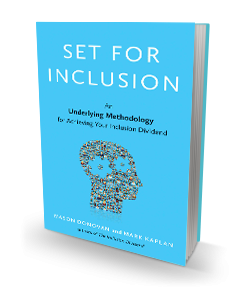 As more companies turn to the cloud to store their data, it is becoming increasingly apparent that diversity and inclusion needs take their data and development out of the clouds. For all too long, D&I has been a lofty concept that has not been able to break out of the stratosphere of awareness. “It’s not good enough to say we value diversity and then under represent women and minorities,” Intel’s CEO Brian Krzanich said as he unveiled a $300 million pledge to improve diversity not only in his company, but also in the industry.
As more companies turn to the cloud to store their data, it is becoming increasingly apparent that diversity and inclusion needs take their data and development out of the clouds. For all too long, D&I has been a lofty concept that has not been able to break out of the stratosphere of awareness. “It’s not good enough to say we value diversity and then under represent women and minorities,” Intel’s CEO Brian Krzanich said as he unveiled a $300 million pledge to improve diversity not only in his company, but also in the industry.
Awareness of the disparity within the workforce in Silicon Valley has become a hotbed issue. Apple, Google and Facebook are just a few of the companies publicly posting their employee demographics in an effort to move the conversation further. Over $8 billion a year is spent globally to develop leaders on D&I. In a Dagoba recent informal poll of Fortune 1000 Chief Diversity Officers, only 30% or less of those funds are focused on legal compliance, while the rest is devoted to creating a more meritocratic culture.
Too much of these funds are focused around raising awareness of the disparity. Awareness is necessary, but not sufficient for today’s conversation. Yes, awareness should be the start of any conversation as it is difficult to fix a problem you don’t understand. However; too many corporations start and end at awareness with the hope that good intent will naturally lead to good impact.
When development of awareness tries to lend itself to action, much of the time it is conceptual action. Leaders walk away from a workshop with written actions to be “more inclusive on talent acquisition” or “cultivate a diverse workforce.” – two very well-intended actions. These leaders are not D&I practitioners so when they get back to their desk, these lofty goals get lost in translation. It is also difficult to measure if the leader has really taken any steps to fulfill these conceptual actions.
D&I needs to be grounded in practical real-world application that can be implemented and measured. These applications do not have to be large and grand. In fact, some of the most important steps are small steps. Small actions will accumulate over time to create real change. Consider the “more inclusive on talent acquisition” action noted above. Almost any leader would believe this is common sense, but then have a difficult time of defining what that means from their perspective. Below are some example practical action items in the screening and resume review process.
- Remove names from resumes before reviewing to eliminate the chance of your perception of gender or ethnicity influencing your decision.
- Rotate your candidate pools on a regular basis to increase diversity. For example, select one new college to target or change one job board per year.
- Ask a diverse group of colleagues to be part of the interview process.
- Expire your job descriptions so that you are forced to update them to reflect your current need as well as their effectiveness to attract a diverse candidate.
These actions can easily be implemented and measured for effectiveness not only at the hire level, but further down the road by tracking employee five-year success rates. A financial industry client recently implementing a practical action focus to inclusion, increased their diversity hires by over 40% in less than 6 months.
Leaders are starved for practical actions they can implement within their sphere of influence. Talent acquisition is just one area where they can make a difference. Client engagement and talent management are two other workforce applications that have had realized success.
The D&I practice also needs to get out of the clouds of focusing only on the intent of the individual. Much of the awareness work has been focused on creating good intent with leaders. For the most part, we find leaders are well-intended. Who wakes up thinking, “how exclusive can I be today?” It is not good for the leader, their team or the organization. Good intent, whether organizational or individual, does not automatically lead to good impact. Development activities that start with the assumption of good intent can more easily focus on good impact because leaders understand that effective leadership is always about matching strategic intent with real impact.
With this direct approach, much of the conceptual consultant-speak can be brought down from the clouds and support leaders to develop practical and immediate measurable actions that will make a difference.


This is a good point. Awareness is easy and feels good, however, the work begins by actually thinking about areas where unconscious bias can affect decisions and actually creating some action plans or process guides to help drive the change.